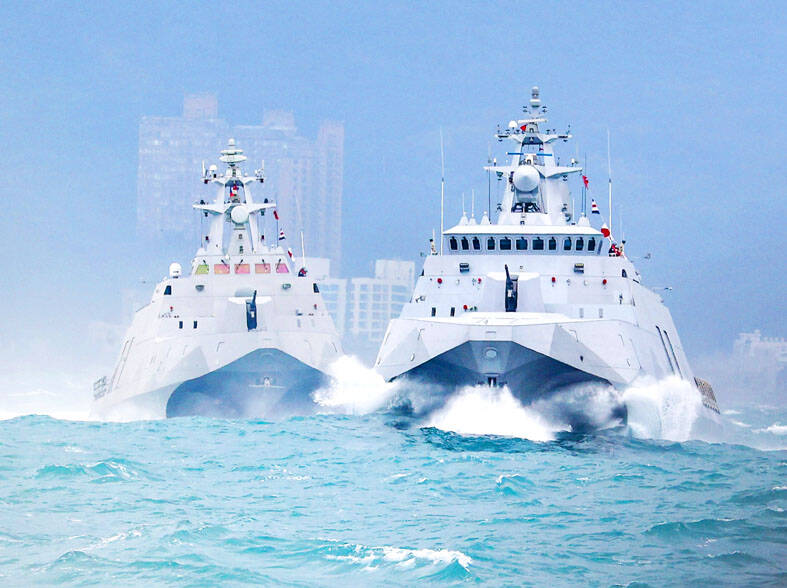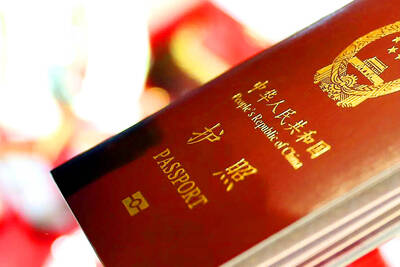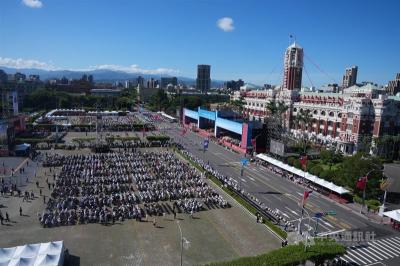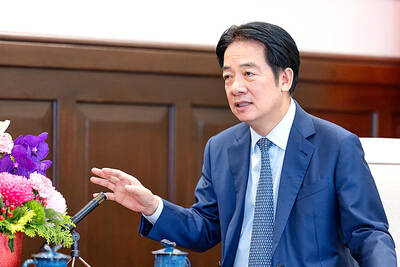The Ministry of National Defense on Wednesday awarded Lung Teh Shipbuilding (龍德造船) a NT$9.7 billion Co (US$317.57 million) contract to build five Tuo Chiang-class corvettes with anti-ship capabilities, a defense official familiar with the matter said yesterday.
The corvettes would carry vertical launchers for four Hsiung Feng II (HF-2) missiles, as well as eight Hsiung Feng III (HF-3) anti-ship missiles, in contrast to ships configured for anti-air warfare, which carry eight HF-2 and four HF-3 missiles, the official said, speaking on condition of anonymity.
The anti-ship corvettes would be armed for improved standoff range against surface combatants and carry the latest HF-2 variant, which has an enhanced range, larger maneuverability and updated electronic warfare technology, he said.

Photo: CNA
Lung Teh was chosen in large part because the shipbuilder had more experience than its competitors, he said.
It previously built the prototype for the Tuo Chiang-class and three anti-air corvettes, and has been tasked with building three more ships of that configuration, he said.
An anti-ship Tu Chiang-class corvette costs NT$7.56 billion when the platform, munitions, combat systems and logistics costs are included, while the program’s overall costs are projected at NT$37.8 billion, government reports showed.
A fleet of 12 Tou-Chiang class corvettes is planned, including the prototype, six anti-aircraft corvettes and five anti-ship corvettes, with the delivery of the last ship scheduled before the end of 2026.
Separately, a copy of the defense ministry’s latest budget proposal to the legislature confirmed that the navy’s submarine rescue ship program would receive NT$10.1 billion under a five-year force restructuring plan.
The move came a year after Democratic Progressive Party legislators Wang Ting-yu (王定宇) and Lin Shu-fen (林淑芬) joined independent Legislator Freddy Lim (林昶佐) in calling for the nation’s indigenous defense submarine program to have dedicated rescue capabilites.
A separate defense official familiar with the matter yesterday said that the budget would enable the navy to develop a defense submarine with deep-sea rescue capabilities, including an adjunct ship, crew and support facilities.
The defense submarine would come in addition to the first of a new class of 3,250-tonne rescue-and-salvage ships, which would enter service in September, the official said, speaking on condition of anonymity.
The new ship’s diving bell would be able to operate at depths of up to 100m and it would be equipped with a remotely operated vehicle that can dive up to 500m, they added.
Even though the ship would be operated by the navy, it would not be used for defense tasks.
The submarine’s rescue ship would have the same capabilities as vessels operated by the US Navy, but it is not yet clear whether it would be interoperable with the navies of the US and Japan, the official said, adding that the matter would have to be discussed with the US.

The Ministry of the Interior (MOI) is to tighten rules for candidates running for public office, requiring them to declare that they do not hold a Chinese household registration or passport, and that they possess no other foreign citizenship. The requirement was set out in a draft amendment to the Enforcement Rules of the Public Officials Election and Recall Act (公職人員選舉罷免法 ) released by the ministry on Thursday. Under the proposal, candidates would need to make the declaration when submitting their registration forms, which would be published in the official election bulletin. The move follows the removal of several elected officials who were

The Republic of China (ROC) is celebrating its 114th Double Ten National Day today, featuring military parades and a variety of performances and speeches in front of the Presidential Office in Taipei. The Taiwan Taiko Association opened the celebrations with a 100-drummer performance, including young percussionists. As per tradition, an air force Mirage 2000 fighter jet flew over the Presidential Office as a part of the performance. The Honor Guards of the ROC and its marching band also heralded in a military parade. Students from Taichung's Shin Min High School then followed with a colorful performance using floral imagery to represent Taiwan's alternate name

COVETED PRIZE: The US president would be a peace prize laureate should he persuade Xi Jinping to abandon military aggression against Taiwan, William Lai said US President Donald Trump should get the Nobel Peace Prize should he be able to convince Chinese President Xi Jinping (習近平) to abandon the use of force against Taiwan, President William Lai (賴清德) told a conservative US radio show and podcast in an interview. The US is Taiwan’s most important international backer, despite the absence of formal ties, but since Trump took office earlier this year he has not announced any new arms sales to the nation. Trump could meet Xi at the APEC summit in South Korea on Oct. 31 and Nov. 1. Lai, speaking on The Clay Travis and Buck Sexton

A Chinese takeover of Taiwan would severely threaten the national security of the US, Japan, the Philippines and other nations, while global economic losses could reach US$10 trillion, National Security Council Deputy Secretary-General Lin Fei-fan (林飛帆) wrote in an article published yesterday in Foreign Affairs. “The future of Taiwan is not merely a regional concern; it is a test of whether the international order can withstand the pressure of authoritarian expansionism,” Lin wrote in the article titled “Taiwan’s Plan for Peace Through Strength — How Investments in Resilience Can Deter Beijing.” Chinese President Xi Jinping’s (習近平) intent to take Taiwan by force